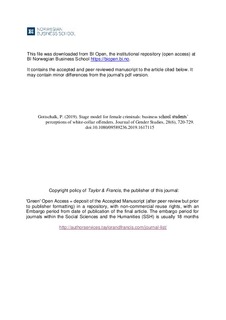Stage model for female criminals: business School student's perceptions of white-collar offenders
Journal article, Peer reviewed
Accepted version
Permanent lenke
http://hdl.handle.net/11250/2607642Utgivelsesdato
2019Metadata
Vis full innførselSamlinger
- Publikasjoner fra CRIStin - BI [1015]
- Scientific articles [2181]
Sammendrag
We know that half of the population in Norway is female, and we know that females represent 6% of the white-collar crime prison population. In the stage model overview, we derive percentages from the literature into the gender model to explain stepwise reduction from 50% to 6%. In our empirical research, we asked two groups of business school students to come up with their own estimates for the stages in the model for female criminals. While estimates from executive students resulted in 3% women in prison, bachelor students’ estimates resulted in 10% women in prison. The most obvious discrepancy between the research literature and our two survey groups is related to relative convictions. Based on the literature, we suggested that female defendants receive more serious convictions because they may perceive and feel more guilt for a crime, for example in terms of regret, shame and depression. Thus women may have a tendency to confess more easily. Both executive students and bachelor students disagree with this estimate of 140%, as they suggest 62% and 69% respectively. One reason for their suggestion of less serious convictions for female white-collar criminals – sometimes labelled pink-collar criminals – might be that family situation and other elements are taken into account before a verdict is passed on a woman. Another substantial discrepancy is related to detection risk. The literature suggests a low detection risk for women, but may be not as low as we estimated at 30%. Both executive and bachelor students believe that the gender difference in detection likelihood is not that formidable, as they suggest 75% and 65% respectively.
